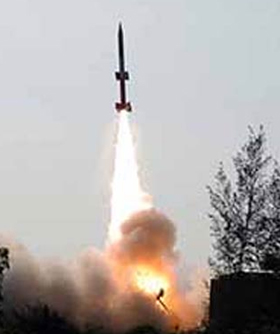ISRO Successfully Tests Scramjet Engine, Could Make Future Launches Cheaper
www.mangaloretoday.com
Chennai, August 28, 2016: India on Sunday morning successfully tested its own scramjet or the air breathing engine with the launch of a big sounding rocket, said a senior official of Indian Space Research Organisation (ISRO). "The mission was successful. Two scramjet engines were tested during the flight. The finer details about the test will be known later," the official not wanting to be quoted told IANS.
"The mission was successful. Two scramjet engines were tested during the flight. The finer details about the test will be known later," the official not wanting to be quoted told IANS.
He said that as scheduled the two stage/engine RH-560 sounding rocket took off from the rocket port located at Satish Dhawan Space Centre (SDSC) in Sriharikota in Andhra Pradesh.
He said the two air breathing engines were like hugging the rocket on its sides and normally when the rocket reaches a height of 11 km the scramjet engines would start breathing air.
"The scramjet engines were ignited 55 seconds into the rocket’s flight. The engines were tested for six seconds," he added.
The scramjet engine, used only during the atmospheric phase of the rocket’s flight, will help in bringing down the launch cost by reducing the amount of oxidiser to be carried along with the fuel.
Later, the ISRO in a statement said: "With this flight, critical technologies such as ignition of air breathing engines at supersonic speed, holding the flame at supersonic speed, air intake mechanism and fuel injection systems have been successfully demonstrated."
The scramjet engine designed by ISRO uses hydrogen as fuel and the oxygen from the atmospheric air as the oxidiser.
The test flight was the maiden short duration experimental test of ISRO’s scramjet engine with a hypersonic flight at Mach 6.
ISRO’s Advanced Technology Vehicle (ATV), which is an advanced sounding rocket, was the solid rocket booster used for testing the air breathing engine.
The rocket weighed 3,277 kg during lift-off.
According to ISRO, some of the technological challenges handled by ISRO during the development of scramjet engine include the design and development of hypersonic engine air intake, the supersonic combustor, development of materials withstanding very high temperatures, computational tools to simulate hypersonic flow, ensuring performance and operability of the engine across a wide range of flight speeds, proper thermal management and ground testing of the engines.
"India is the fourth country to demonstrate the flight testing of scramjet engine. The successful technology demonstration of air-breathing scramjet engines in flight by ISRO is a modest yet important milestone in its endeavour to design and develop advanced air breathing engines including engines for ISRO’s future space transportation system," the space agency added.
- Kadaba acid attack victim writes CET in Mangaluru
- EC dismisses concerns as Kasaragod mock poll sparks row
- Malpe: 3 tourists washed away by strong tidal waves; 2 rescued; 1 drowns
- IMD predicts rain, thunderstorms across Karnataka for next 3 days
- WhatsApp will soon let you see which of your friends were recently online
- Kasaragod: SC asks EC to check reports of EVMs registering ‘extra votes’ for BJP in mock polls
- Elect a representative who works for you, Hegde tells voters
- St Joachim church Kadaba, commemorated its Centenary celebration on April 17
- BJP seeks Rahul Gandhi’s answer to State’s ‘bankruptcy’
- PM’s letter of appreciation for Mangaluru artist who sketched his portrait
- Puttur: Bike-jeep collision claims rider’s life
- Bantwal: Man arrested for stabbing Hindu Yuva Sene leader
- Bantwal: Woman jumps into river in front of her father, daughter
- Elon Musk’s message of peace amid Israel-Iran tensions: ’Send rockets to stars’
- Rajinikanth, Kamal Haasan, Dhanush, Vijay Sethupathi vote in Chennai
- Vice Admiral Dinesh Tripathi appointed as next Indian Navy chief
- Iran shoots down several drones, US officials suspect Israel: 10 points
- Voting in 21 states today as India’s National Election begins: 10 Points
- India likely to deliver first batch of Brahmos missiles to Philippines today
- Congress corporator’s daughter stabbed to death in college, attack on CCTV
- Woman, part of Indian crew on board ship seized by Iran, returns home
- Kejriwal eating food high in sugar despite diabetes to make grounds for medical bail: ED tells court
- Explained | Why Lok Sabha polls is spread over six weeks
- Businessman Raj Kundra’s properties worth nearly ₹ 100 crore seized
- Nestle India says ’have been cutting sugars in baby food’ after damning report
- New residential complex for the judges inaugurated in Mangaluru
- Absconding accused nabbed after 8 years
- Truck with cylinders turns turtle in Beltangady
- Bhoota Kola artist dies of cardiac arrest
- Development of the country should be our goal: Ganesh Karnik
- Container truck gets stuck under Modankap railway bridge
- Truck crushes bike’s pillion rider near BC Road
- Head constable dies of heart attack
- Udupi: PDO dismissed over financial irregularities
- CREDAI to resume Skill Development Program for Construction Workers in Mangaluru
- John B Monteiro elected president of Rachana Catholic Chamber of Commerce & Industry
- Sudhanshu Rai elected district president of All College Student Association
- Chief Minister to visit Mangaluru, Udupi on August 1
- Nitte University awards PhD degree to Tina Sheetal D’Souza
- Sachitha Nandagopal honoured by CMTAI for Community Service
- CITY INFORMATION
- TRAVEL
- TOURIST INFORMATION
- HEALTH CARE
- MISCELLANEOUS




 Write Comment
Write Comment E-Mail To a Friend
E-Mail To a Friend Facebook
Facebook Twitter
Twitter  Print
Print 

